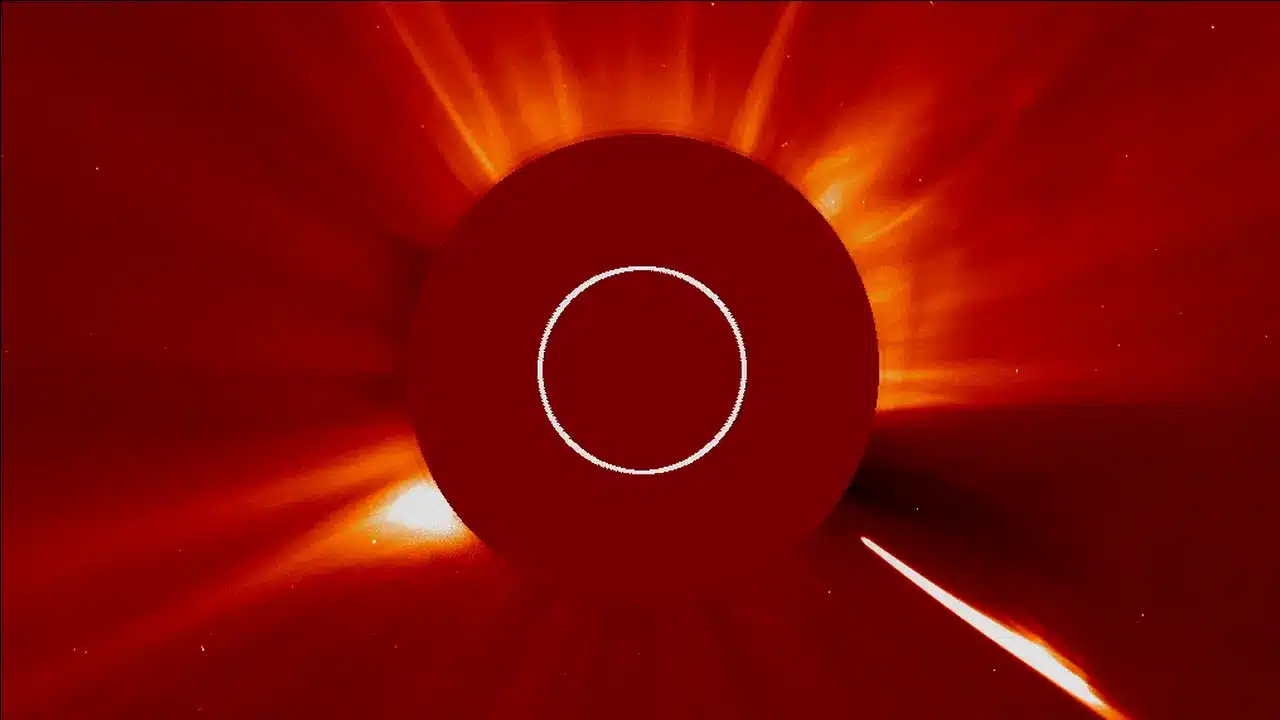About Sungrazing Comets
- Sungrazing comets are a special class of comets that come very close to the sun at their nearest approach, a point called perihelion.
- To be considered a sungrazer, a comet needs to get within about 850,000 miles from the sun at perihelion.
- Many come even closer, even to within a few thousand miles.
- Being so close to the sun is very hard on comets for many reasons.
- They are subjected to a lot of solar radiation, which boils off their water or other volatiles.
- The physical push of the radiation and the solar wind also helps form the tails.
- As they get closer to the sun, the comets experience extremely strong tidal forces, or gravitational stress.
- In this hostile environment, many sungrazers do not survive their trip around the sun.
- Although they don’t actually crash into the solar surface, the sun is able to destroy them.
- Most usually evaporate in the hot solar atmosphere.
- Orbit: Most of the sungrazing comets observed follow a similar orbit, called the Kreutz Path, a single orbit that takes 800 years to complete.
- They collectively belong to a population called the Kreutz Group.
- These Kreutz comets are fragments from a single large comet that was shattered thousands of years ago.
- The far end of the Kreutz path lies 160 times farther from the sun than the orbit of Earth.
What is a Comet?
- Comets are frozen leftovers from the formation of the solar system, composed of dust, rock, and ice.
- They orbit the sun in highly elliptical orbits that can take hundreds of thousands of years to complete.
- They range from a few miles to tens of miles wide, but as they orbit closer to the Sun, they heat up and spew gases and dust into a glowing head that can be larger than a planet.
- The dust and gases form a tail that stretches away from the Sun for millions of miles.
· According to NASA, as of January 2023, the current number of known comets is 3,743. Though billions more are thought to be orbiting the sun beyond Neptune in the Kuiper Belt and the distant Oort cloud far beyond Pluto.
Q1: What is a total solar eclipse?
A total solar eclipse is a condition when the Moon passes between the Sun and the Earth and completely blocks the Sun’s disk, casting a huge shadow on the surface. People viewing the eclipse from locations where the Moon’s shadow completely covers the Sun–known as the path of totality–will experience a total solar eclipse. As per NASA, during this timeframe, the sky will darken, resembling the onset of dawn or dusk.
Source: Total solar eclipse reveals tiny new comet moments before it was destroyed by the sun
Last updated on December, 2025
→ Check out the latest UPSC Syllabus 2026 here.
→ Join Vajiram & Ravi’s Interview Guidance Programme for expert help to crack your final UPSC stage.
→ UPSC Mains Result 2025 is now out.
→ UPSC Notification 2026 is scheduled to be released on January 14, 2026.
→ UPSC Calendar 2026 is released on 15th May, 2025.
→ The UPSC Vacancy 2025 were released 1129, out of which 979 were for UPSC CSE and remaining 150 are for UPSC IFoS.
→ UPSC Prelims 2026 will be conducted on 24th May, 2026 & UPSC Mains 2026 will be conducted on 21st August 2026.
→ The UPSC Selection Process is of 3 stages-Prelims, Mains and Interview.
→ UPSC Result 2024 is released with latest UPSC Marksheet 2024. Check Now!
→ UPSC Prelims Result 2025 is out now for the CSE held on 25 May 2025.
→ UPSC Toppers List 2024 is released now. Shakti Dubey is UPSC AIR 1 2024 Topper.
→ UPSC Prelims Question Paper 2025 and Unofficial Prelims Answer Key 2025 are available now.
→ UPSC Mains Question Paper 2025 is out for Essay, GS 1, 2, 3 & GS 4.
→ UPSC Mains Indian Language Question Paper 2025 is now out.
→ UPSC Mains Optional Question Paper 2025 is now out.
→ Also check Best IAS Coaching in Delhi

















